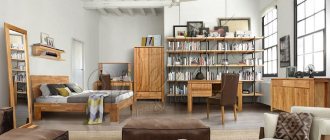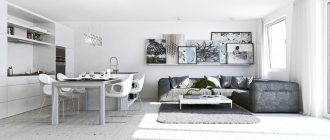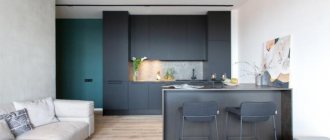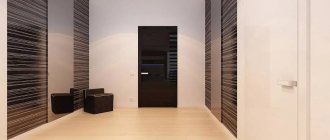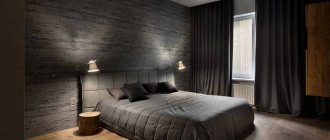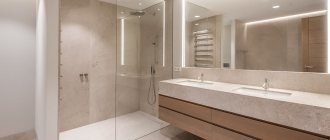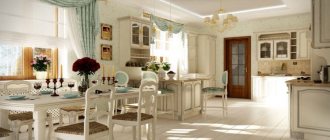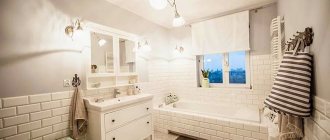A characteristic feature of a minimalist interior is its ability to create a comfortable living environment even in the most cramped conditions, using only the items necessary for life. The direction was fully formed in the 1960-1970s, replacing constructivism, which was fashionable at the beginning of the century.
Practicality, functionality, overall simplicity and the rejection of everything superfluous have allowed it to remain one of the most popular interior styles today.
History of minimalism in architecture and interior design
Minimalism as a movement finally took shape in the second half of the 20th century. It replaced the overly decorative Art Nouveau style, which after World War II evoked negative associations with bourgeois society. The pace and style of life also changed - people rushed towards simplicity and reliability.
The origins of minimalism are the Japanese style, which penetrated into Western culture after the war. The influence of constructivism is important. The main principles of these trends are rigor, geometricism and compliance of the external appearance of the building with its functions.
A major role in the emergence and formation of minimalism was played by “Style”, a society of artists that originated in the Netherlands. It laid the foundations for the future trend.
Speaking about the history of minimalism in design and architecture, one cannot fail to mention the German Ludwig Mies van der Rohe. He sought to simplify the appearance of the building as much as possible and free up space. The main motto of his work was “less is better.”
Minimalism: main features of style
- use of natural materials
- a lot of free space
- functional furniture
- geometric shapes
- closed storage systems
- monochrome color scheme
- big windows
- hidden light sources
- rejection of unnecessary decor
Materials
In minimalism, preference is given to natural materials: stone, wood, leather, linen fabrics, etc. Often they are not processed, focusing on rough texture (brick, concrete, plaster). The use of metal makes the interior more modern - metal chair legs, table tops, and shelving racks look good.
The proximity of natural materials to artificial ones is not excluded. The main thing is to find a balance between them. Particular attention is paid to the combination of glossy surfaces with polished ones, and wooden surfaces with plastic ones.
In conclusion
Finally, we note that there is not so much decor Large wall clocks, interesting paintings, vases and mirrors are best suited for this role, but some other elements will also look appropriate. Minimalism is perfect for owners of small apartments, living space in Khrushchev-era buildings, studio apartments, as well as those who like their apartment to not have an abundance of unnecessary items.
The article was written for the site.
Tags: Apartment design, Interior style
Decorating ceilings, walls and floors in minimalism
A minimalist ceiling does not involve any complex structures. The simplest solution is to cover it with paint.
When decorating the walls, concrete, glass, and natural stone with a pronounced relief are used. You can cover them with textured plaster or cover them with plain wallpaper without a pattern. Despite the eloquent name of the style, there are many options.
The floor is decorated using laminate, parquet or porcelain tiles. The rules are the same: no patterns or ornaments, neutral shades, plain materials.
Finish options
The simplicity inherent in minimalism begins with finishing work. It is important to achieve conciseness without overloading the space with shades and details.
- ✔ The walls
should be as calm and discreet as possible so that the visitor’s gaze does not stop on them. Decorative plaster or ordinary paint will work well here. Wallpaper is used less often and only in plain colors or for painting. The color of the walls most often remains white. - ✔ The floor
is made monochromatic, allowing for both light and dark options. It is usually finished with natural wood or laminate. If you choose parquet, it should be simple, without patterns. Less commonly used are linoleum or carpet. Ceramic tiles without a pattern are laid in the kitchen, bathroom, toilet and, sometimes, the hallway. - ✔ The ceiling
must be light in color. It can be either the most ordinary (stretched or whitewashed), or complex, multi-level.
White walls in minimalism
Light wooden floor in minimalism
Simple light ceiling with laconic built-in lights
Furniture
In an ideal minimalist interior, furniture takes up only 20% of the space. Its main features are geometric shapes, simple natural materials and functionality. The combination of several functions in one piece of furniture (sofa bed, transformable table) helps to avoid cluttering the space. For the same purpose, the room is often equipped with built-in appliances.
Much attention is paid to storage systems. It is best if they are hidden - only a few really worthwhile things remain in sight, reflecting the individuality of the owner. For example, the ideal solution for a bedroom would be a spacious wardrobe, discreetly mounted into the wall.
History of style
The minimalism style arose at the peak of the era of modernism, when there was a rethinking of values (the second half of the 20th century). People are tired of non-functional pomposity and pretentiousness.
Expressiveness and functionality have replaced it. Interior elements are not only aesthetics, but primarily functionalism. The basis is also based on Japanese culture motifs.
Color spectrum
Earlier we noted that the origins of minimalism are the Japanese style. Therefore, their color palette is similar. White, light grey, beige and brown shades are predominantly used: they fill the space with light.
To create a harmonious interior in a minimalist style, designers use only two or three main shades. The favorite color remains white. It can be effectively diluted with black surfaces, graphic gray or bright accents.
Lighting
Much attention is paid to natural lighting. Large, unshaded windows are a great way to create a spacious, airy space. As a last resort, use horizontal or vertical blinds.
When it comes to artificial lighting, it is advisable to keep the light sources hidden. Soffits, multi-level ceilings with lighting, etc. will come to the rescue. It is possible to use laconic lamps, floor lamps or chandeliers of simple geometric shapes.
Light
Good lighting is a must-have for the minimalist style. In this case, it is better to avoid too intense direct light. The ideal option is a soft, diffused glow that envelops the space. As much sun as possible should come from the street through large windows that are not covered with curtains.
Soft diffused light creates a special atmosphere
Artificial light is provided by numerous lamps located not only on the ceiling, but also on the walls, as well as on cabinets and tables.
Chandeliers are practically not used in minimalism. Built-in lamps of simple geometric shapes are much better suited.
Japanese minimalism
As we have already noted, the ideas of minimalism came to Europe from distant and mysterious Japan. In this country with a special contemplative philosophy and frequent earthquakes, people came up with lightweight and mobile homes, actually created from bamboo and paper. They were easy to carry and restore. Plus, such structures were not threatened by tremors. The high population density made us strive for open spaces, and the love of nature and sunlight helped create soft, diffused lighting in the house without bright accents.
To create an interior in the style of Japanese minimalism, free up space to the maximum, and use light partitions and screens for zoning. Furniture in such an interior should be low and without unnecessary decor.
Scandinavian minimalism
The emergence of another variation of the minimalist style was influenced by the northern climate and lack of sunlight. The harsh Swedes, Finns and Danes already in the 19th century began to give preference to spacious rooms in light colors. Scandinavian minimalism is perhaps the coziest version of this style. Indoor flowers, soft blankets and pillows would be appropriate here.
Features of the design of a small apartment
When carrying out major renovations in a small apartment, you want to turn it into a cozy and comfortable home. However, the small area of the premises may become an obstacle. In this case, you can use a minimalist style.
Recommendations for decorating the space:
- Paint the walls and ceiling white. This technique will help to visually increase the area of the rooms and add light.
- Furniture includes a wardrobe, a pull-out bed, and shelves for books. The kitchen should be in light, discreet colors with built-in household appliances. You can increase the area of the premises by using furniture that can be folded during the day (transformable bed, secretary, sliding table top, etc.).
- If the kitchen and living room are separated by a partition rather than a solid wall, then it can be dismantled. Instead of this barrier, a bar counter or a compact extendable dining table is installed on the border between the rooms.
- An open hanger is installed in the hallway for clothes, and a rack is built for shoes.
All of the above measures will help save and expand the small area of the apartment, and small accent items, skillfully matched to the interior, will make the furnishings of the rooms comfortable and cozy.
Minimalism = hi-tech?
High-tech style is an ultra-modern manifestation of the ideas of minimalism. It originated in the 1970s in Great Britain, when the design of industrial premises with industrial equipment on display developed into an independent movement. The main difference from the minimalist style is the designer’s rethinking of advanced technologies and the use of only modern materials. Functionality is what comes first here.
If you want to combine minimalism and hi-tech, use technical elements as decoration: all kinds of fasteners, pipes, metal parts and rivets. Also flaunt all the latest technological achievements
